Chapter 34 Grafting Roots to Improve Nebari
Inevitably you will have trees with less than ideal root spread. For example, the photo below shows the trunk base of a Japanese maple. At the front of the trunk is a large gap in the nebari. There are several hit-or-miss techniques for stimulating new roots, but any that grow will take many years to thicken. The faster way to add a suitable root in this position is to either approach graft or thread graft a young tree into the gap. Once grafted, the trunk of the young tree becomes a root of the main tree itself.
This article is based on two very good online articles written by Harry Harrington for Bonsai Solutions in Australia.
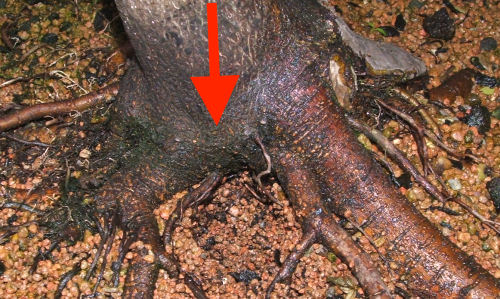
Nebari of a Japanese maple. The arrow shows a gap in the root flare that could benefit from a graft. Link to image source.
Due to the thickness and flare of this trunk, approach grafting is going to be the easier method to use.
34.1 Preparing the Graft Site
In late summer (see timing notes below), remove some soil from the area where the new tree will be planted. Disturb roots of the main tree as little as possible. Alternatively, plan ahead. When repotting the tree in spring, put a rounded rock in the pot where the graft will be planted. This reserves space for the graft sapling’s roots. Remove the rock when you are ready to graft.
For the new root, choose a seedling of the same species (and cultivar if possible) up to the diameter of a pencil.
Cut a channel that is just wide enough to receive the sapling into the trunk base where you want the new root. Cut the channel about half as deep. Do not cut it too deep; your goal is for the grafted sapling to form a slight mound where it leaves the main trunk.
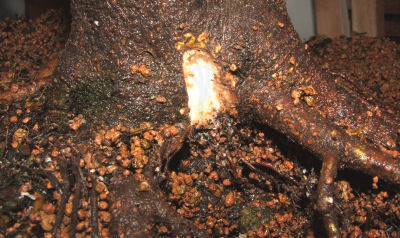
Preparing the site for an approach graft. The channel is just wide enough to receive the sapling into the trunk base. Link to image source.
At this point you have two options for how you prepare the sapling for grafting.
34.1.1 Mr. Harrington’s Method
This method for getting the sapling and trunk to fuse is more conservative and slower, but less likely to fail. As the sapling grows in diameter, it compresses against the trunk wood, creating small breaks in the sapling bark. The wounds exposes cambium that fuses to the main tree. The downside here is that bark is tapped inside the trunk, leaving a potential weak spot. This is not a problem so long as the new root is not pulled or twisted.
- Wipe the sapling with a moist, clean cloth to remove any dust or dirt. Push the sapling into the channel.
- Drive a thin brass screw through the sapling and into the trunk. This will hold the sapling in place.
- Immediately put wound sealant, grafting paste, oil-based modeling clay, or some other tacky material over the cut edge of the trunk where it meets the sapling.
- Pack soil around the roots of the sapling, and water well.
- Let the sapling grow freely and vigorously until the cambium layers of the sapling and main trunk graft together. It will take 1-2 years.
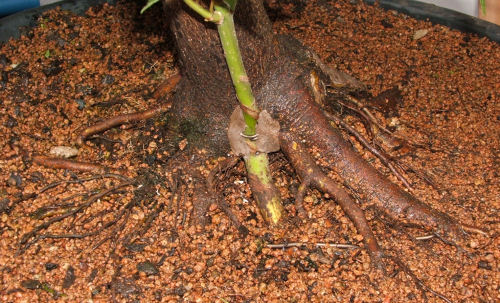
The newly completed approach graft. Putty seals the edges so the graft joint does not dry out. Link to image source.
34.1.2 Open Wound Method
This method leads to faster fusion, but is harder to do. The graft also is more at risk of drying out and failing. Making sure the cambium of both trunk and sapling are in direct contact is essential.
- Cut the channel a hair’s breadth too small for the sapling.
- Just before pushing the sapling into place, shave off the outer bark on either side where the sapling will contact the channel, exposing the inner green cambium.
- Push the sapling into place, anchor it with a brass screw, and cover it with sealer as described in the previous method.
Do not cut the outer bark of the sapling too far around the circumference or too deep. Saplings will die if the cambium is broken too far around the circumference, or the cut is too deep to heal in.
In the end my opinion is, if you are not in a hurry, it is better to stick with the slower method.
34.1.3 After Care
In 1-2 years, the sapling will fuse to the trunk. Strong fusion joints will form woody bark below the connection points.

The approach graft after a year. The area below the union already has formed woody bark. The area above the graft union still has green bark. The top of the graft should stay in place for another year. Link to image source.
After the new root is well fused, cut off the top of the sapling and remove the brass screw, leaving the base as a new root. Seal the screw hold with wound paste so it does not dry out while the hole closes.
34.2 Thread Grafting
Thread grafts can be used to add new branches or improve weak or unbalanced nebari. A young, pliable shoot is threaded through a hole drilled in the trunk of the tree. As the shoot grows and fattens, the cambium layers of the shoot and the trunk are forced together and fuse.
Thread grafts are easier to make and fuse more reliably than approach grafts but they must be made using smooth unbranched seedlings; grafts cannot be made with larger or heavily branched seedlings. This limits the size of usable materials, and so limits the size of the graft.
Thread grafting is done before the seedling starts to bud out in spring.
- Bare-root the seedling and remove all side branches flush with the stem.
- Drill a hole through the root or trunk of the bonsai.
- If need be, drill the entry hole while the tree is out of the pot.
- Try to make the exit hole for the graft in a position where it will be hidden from view.
- Use a wood drill bit that is slightly larger than the diameter of the seedling so the seedling can be introduced through the hole without damage. However, making the hole too big will increase the time needed for the graft to take.
- If a large diameter drill bit is needed for the seedling to fit, use thinner bits to make an initial pilot hole and gradually widen the hole with larger bits.
- Thread the seedling through the hole until it is in position.
- Cover the roots of the seedling with soil and fill the wounds with cut paste.
- Let the seedling grow as much as it can the first year to force the cambial layers together.
- When the seedling and the main tree have visibly joined and healed together, gradually prune back the seedling until only the roots are left. Be patient; this will take at least a year.
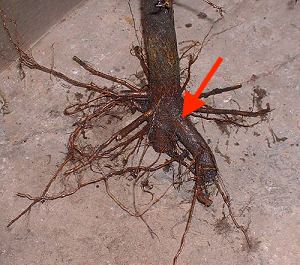
A bare-rooted tree with a large unbranched root (red arrow). This is the location chosen for a thread graft. Link to image source.

The tree from the previous figure immediately after repotting. The point on the root where the thread graft will go is just above soil level. Link to image source.

A bare-rooted dormant seedling, ready to be threaded. Link to image source.
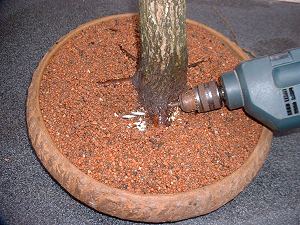
Drilling out the channel for the graft. Link to image source.

The finished channel for the graft. Link to image source.

The threaded seedling in place, with roots covered in soil. Link to image source.

A mature thread graft. This is a different tree than the one shown in other photos. The straight sapling emerging from the top of the root mass is the only indicator of where the original graft is located. Link to image source.